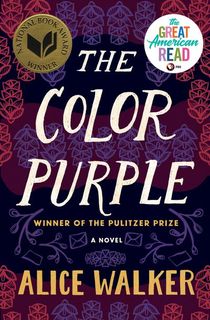Alice Walker and Gloria Steinem have a long history together. Steinem, who famously co-founded Ms., a liberal feminist magazine, first began to publish Walker's work in the 1970s before hiring her as one of the magazine's first black editors. This was years before Walker would become famous for authoring The Color Purple, which was published in 1982. Below, Steinem explains why Walker's most famous work is more than deserving of all its accolades—and why it's worth reading again and again.
Related: National Book Award Winners to Add to Your TBR Pile
I’ve noticed that great books have two common and unfair fates. The obvious first is not to be known enough for readers to find. The second is to be so well-known that readers imagine they’ve absorbed it and needn’t look again.
I think The Color Purple may be suffering the second fate. Thirty-two years after it was published—winning both the National Book Award and the Pulitzer Prize—many readers think they know it from reading about it in school, from seeing the good-spirited Hollywood movie that was based on it, or just from hearing so much about it.
Related: Revisiting The Color Purple: A Discussion with Alice Walker
I myself thought I knew it because I had read it in manuscript, and told all who would listen that Alice Walker would now be recognized as the great American writer she always was. I was happy that Ms. magazine could publish an excerpt and photograph her for the cover.
There is also a painful side to this possibility of being known but not understood. Especially after the movie came out, there was a storm of protest from some African American church groups and well-known male writers who disapproved of showing love between women and violence against women within their community. To know how painful that was to Alice, read her book The Same River Twice: Honoring the Difficult. To know Alice herself, see Beauty in Truth, a documentary about Alice’s life made by Pratibha Parmar and shown on PBS.

Only after that conflict died down did I begin to see—just from traveling around this country, as I spend half my life doing—how life-giving The Color Purple was to people who knew nothing of the controversy, but just picked up a copy in, say, one of the small stores of used paperbacks where poor readers buy books.
Gradually, I realized that it was the only great novel about the poor that everyone—including the poor—was likely to read. From Gorky to Balzac and Steinbeck, many have written about poor or country people, but usually for a different audience, complete with condescending apostrophes and quotation marks to indicate misspellings and incorrect words.
Alice does no such thing. On the contrary, she writes in what she calls her “first language.” As the youngest of eight children in a sharecropping family in rural Georgia, she knows this language with no condescension, not to the people speaking or the reader. There is poetry, depth, the reasons for inventing God, and the miracles of nature, the realities of cruelty, and also the possibility of redeeming the cruelest among us.

Alice Walker and Gloria Steinem on the the Fall 2009 cover of Ms. magazine. Wikipedia.
On trips to other countries, I accidentally met the woman who translated The Color Purple into Japanese, and then another who translated it in into Chinese. Each told me separately that in order to convey the spirit of The Color Purple, they had to use the language of the country people in those countries. It was the first time this had been done in the most respected of literary works.
A true thing creates truth wherever it goes.
All this, plus Celie and Shug and Mr. _____ and the people who enter our lives and dreams, is why I urge reading The Color Purple. It’s a book you won’t be the same person after reading. Even if you’re reading it again.
Related: Beyond The Color Purple: 9 Must-Read Alice Walker Books
Download The Color Purple now.
About the Author
Gloria Steinem is an American feminist, activist, writer, and editor who has shaped debates on gender, politics, and art since the 1960s. Cofounder of Ms. Magazine and a founding contributor of New York Magazine, Steinem has also published numerous bestselling nonfiction titles. Through activism, lectures, constant traveling as an organizer, and appearances in the media over time, Steinem has worked to address institutional inequalities of sex, race, sexuality, class, and access to power in the United States and abroad.

